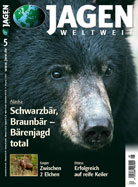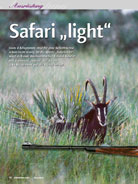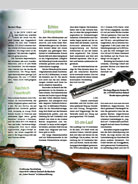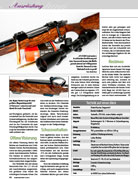Jagen Weltweit 05/2013 - Equipment, Norbert Klups
Safari "light"
A good 4 kilograms is really not very much for a safari rifle. The gunsmith Roland Kessler is now daring to enter the "featherweight" division with the new "Safari", which weighs just 3.45 kilograms.
When JAGEN WELTWEIT 3/2013 was on the market, I received a phone call from Roland Kessler from Deggendorf: "If you want to have a go at firing a really light .375 H & H, I will send you my new "Kesslerin". It doesn't even weigh 3.5 kilograms." This was a tempting offer which I was only too happy to accept.
The Kesslerin bolt-action rifles are all produced according to customer requirements, and so each weapon is an individual item in its own right. The gunsmith sent me the rifle as a left-handed version. The scales impressively confirmed that it weighed just 3.45 kilograms. For a .375 H & H this is very, if not alarmingly light.
Plenty of firepower
A normal Kesslerin holds three cartridges in a standard calibre. Thick magnums usually only hold two. For a rifle which is targeted at dangerous big game, this is clearly not enough. But Roland Kessler is a pragmatist and an experienced hunter. His "big Kesslerin" swallows three cartridges, and the fourth can be loaded directly into the barrel. The higher magazine capacity is achieved by what is known as a "Rigby cap", which is milled out on the inside and thus increases the magazine capacity by one cartridge.
Genuine left-handed system
Converting an old 98-type military system to be left-handed scarcely makes any sense, and genuine left-handed 98-type military weapons never existed. The Kesslerin is therefore provided with a completely newly fabricated 98-type system in a left-handed design. Roland Kessler largely sticks to the original system here. Only the cartridge case has been configured much slimmer and everything has been designed for left-handed marksmen.
Whereas with an original system the cartridge case has a diameter of 38.5 millimetres, the Kesslerin measures just 33. This is particularly apparent not just with the dimensions, but also with the weight.
The Kesslerin is extremely slim in the area of the magazine box. The case bridges were worked as a double-square bridge from the full material. This enables a very elegant scope mount to be produced. The 14 millimetre prism piece for tightening the rear foot of the scope is milled directly from the rear case bridge, and the swivel ring for the front foot is simply placed and screwed into the front bridge from above. This means that nothing needs to be soldered on, and everything looks like it comes from one cast. It could not be more elegant and durable.
The long Mauser extractor and the case ejector in the rear case bridge correspond to the original. The bolt holder sits in the rear bridge, but everything is arranged back-to-front here. The bolt handle, extractor, bolt catch and ejector are each located on the other side of the system. The horizontally working 3-position safety catch on the flat small lock is also fitted on the left-hand side. The system runs in a silky-smooth way and can be repeated fluently. Everything is polished and ideally coordinated.
One of the conventional triggers for 98-type systems cannot be used because of the reduced overall height. The direct trigger designed by Kessler specifically for this system can be individually adjusted from 600 to 1,200 grams and releases drily and without any noticeable travel. The first stage trigger travel, pull weight and trigger stop can all be adjusted. In the case of the test weapon, the trigger was set at a practical 750 grams.
55 cm barrel
The barrel length of 55 centimetres is probably the lowest limit for a .375 H&H. However, the barrel length is the best place to save weight. In order to see how much performance the 10 centimetre shorter barrel costs, the muzzle velocity was measured. The RWS loading with the 19.5 gram UNI Classic is specified as being 760 m/s. 748 m/s were measured from the 65 cm barrel of a rifle. The bullet leaves the barrel of the Kesslerin at a velocity of 702 m/s — a noticeable loss of performance which was to be expected. Compared to 5,450 joules, the muzzle energy falls to 4,800 joules, and the SID is reduced from 160 to 152 metres. The extent to which this has any practical influence depends on the hunt.
What catches the eye about the Kesslerin is the slender, streamlined stock with a straight back and German cheek piece. The front stock becomes much narrower towards the front and is finished off with buffalo horn. A flat pistol grip emphasises the elongated line of the elegant casing. The buttstock is finished off with a narrow "English red" rubber cap. The front stock and pistol grip are blended with fine fish skin.
The wooden/metal seat of the weapon was executed with particular care. Like the system bedding made of artificial resin, it ensures an exact system fit. The stock is made from honey-coloured, richly grained walnut wood, is elaborately polished and given a high-gloss finish with oil. One special feature that the test weapon had was a system extension extending beyond the pistol grip as far as the stock nose and on the bottom as far as the small pistol grip cap. This ensures a special level of stability and looks exclusive.
The long magnum system for the .375 H & H is specially manufactured by Roland Kessler
Top-class workmanship packaged in an elegant guise: the "Safari version" of the Kesslerin in a left-handed design
Open sights
As an open sight, the rifle has a folding rear sight with a 3 millimetre wide rectangular notch as well as a 2 millimetre bead to go with it. The notch is pushed into the side of the dovetail of the barrel holder which is soldered on.
The test weapon was equipped with a Swarovski glass scope Z6i 1.7—10 x 42 with an illuminated reticle. A larger glass scope would disrupt the streamlined contours. The glass scope almost looks slightly too modern on the weapon. The upper parts of the scope mount come from Recknagel. Kessler uses the Eramatic swivel mount. In test firing, there were no changes to the position of the target point even after repeated removal and attachment of the scope.
Firing characteristics
A hunting rifle must be built first and foremost so that the owner can use it to hit the target reliably and safely. Weapons which are too light can therefore be problematic if the recoil forces are high. The test firing with the light .375, which with the scope weighs just about 4 kilograms, was therefore anticipated with great excitement.
Despite the slender stock design, the Kesslerin rests very comfortably in the shooting position, and even fully grown men can handle this slender rifle well and safely. A shot was first of all fired from the shoulder from a standing position. However, the first shot was greeted with astonishment: It recoiled much less than was expected. There was scarcely any difference compared to my own .375, which weighs a good 1.5 kilograms more. The stock design has evidently worked very well and delivers pleasant firing characteristics. A full magazine could be emptied in less than 6 seconds, and all shots landed in the 9 section of the young wild boar disc from a distance of 50 metres away. From the shooting table, the test weapon fired 5 shots from a cold barrel in each case at a test target measuring 2.9 centimetres. A first-class result for this sleek rifle!
Verdict
A big game bolt-action rifle can scarcely be made any lighter! It is the ideal weapon for long treks under the African sun. The delicate rifle not only looks elegant and smart, but is also very precise and can be fired without any problems. The standard version of the Kessler Großwild starts from 18,900 euros. For this you get top-class quality and an individual touch.
Technology at a glance
|
|
Manufacturer |
Roland Kessler, Deggendorf |
Model |
Kessler Großwild |
Calibre |
Test weapon .375 H & H, other calibres possible |
Bolt assembly |
New 98-type left-handed system with a long Mauser extractor |
Magazine |
Box magazine for 3 cartridges mounted in a zigzag fashion, folding lid |
Trigger |
Direct trigger |
Pull weight |
750 g (can be adjusted from 600 to 1,200 g) |
Safety mechanism |
3-position safety mechanism at side |
Barrel |
Lothar Walther |
Barrel length |
55 cm |
Sight |
Folding rear sight with rectangular notch, bead, sight base soldered on, bead base pulled over the barrel with ring |
Stock |
Made from very good walnut wood in a polished oiled finish. Straight stock and German cheek piece. Fish skin on pistol grip and front stock, rubber stock cap |
Scope |
Swarovski 1.7—10 x 42 with illuminated reticle |
Mount |
Eramatic swivel mount |
Weight |
3,450 g |
Total length |
110 cm |
Price |
From 18,900 euros (excluding scope) |





